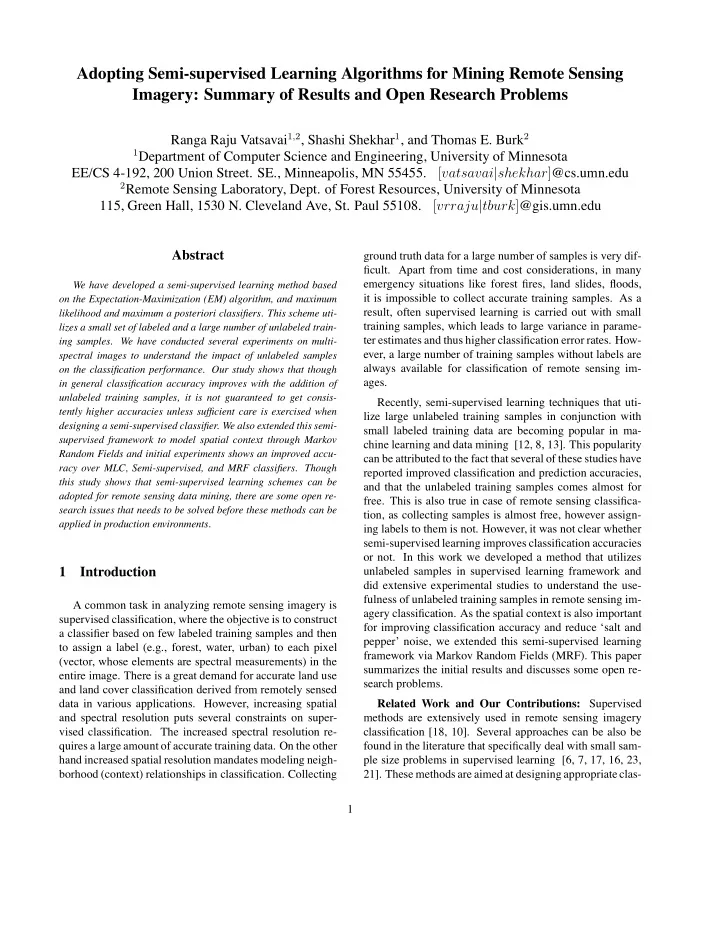

Adopting Semi-supervised Learning Algorithms for Mining Remote Sensing Imagery: Summary of Results and Open Research Problems Ranga Raju Vatsavai 1 , 2 , Shashi Shekhar 1 , and Thomas E. Burk 2 1 Department of Computer Science and Engineering, University of Minnesota EE/CS 4-192, 200 Union Street. SE., Minneapolis, MN 55455. [ vatsavai | shekhar ] @cs.umn.edu 2 Remote Sensing Laboratory, Dept. of Forest Resources, University of Minnesota 115, Green Hall, 1530 N. Cleveland Ave, St. Paul 55108. [ vrraju | tburk ] @gis.umn.edu Abstract ground truth data for a large number of samples is very dif- ficult. Apart from time and cost considerations, in many emergency situations like forest fires, land slides, floods, We have developed a semi-supervised learning method based it is impossible to collect accurate training samples. As a on the Expectation-Maximization (EM) algorithm, and maximum result, often supervised learning is carried out with small likelihood and maximum a posteriori classifiers. This scheme uti- training samples, which leads to large variance in parame- lizes a small set of labeled and a large number of unlabeled train- ter estimates and thus higher classification error rates. How- ing samples. We have conducted several experiments on multi- ever, a large number of training samples without labels are spectral images to understand the impact of unlabeled samples always available for classification of remote sensing im- on the classification performance. Our study shows that though ages. in general classification accuracy improves with the addition of unlabeled training samples, it is not guaranteed to get consis- Recently, semi-supervised learning techniques that uti- tently higher accuracies unless sufficient care is exercised when lize large unlabeled training samples in conjunction with designing a semi-supervised classifier. We also extended this semi- small labeled training data are becoming popular in ma- supervised framework to model spatial context through Markov chine learning and data mining [12, 8, 13]. This popularity Random Fields and initial experiments shows an improved accu- can be attributed to the fact that several of these studies have racy over MLC, Semi-supervised, and MRF classifiers. Though reported improved classification and prediction accuracies, this study shows that semi-supervised learning schemes can be and that the unlabeled training samples comes almost for adopted for remote sensing data mining, there are some open re- free. This is also true in case of remote sensing classifica- search issues that needs to be solved before these methods can be tion, as collecting samples is almost free, however assign- applied in production environments. ing labels to them is not. However, it was not clear whether semi-supervised learning improves classification accuracies or not. In this work we developed a method that utilizes 1 Introduction unlabeled samples in supervised learning framework and did extensive experimental studies to understand the use- fulness of unlabeled training samples in remote sensing im- A common task in analyzing remote sensing imagery is agery classification. As the spatial context is also important supervised classification, where the objective is to construct for improving classification accuracy and reduce ‘salt and a classifier based on few labeled training samples and then pepper’ noise, we extended this semi-supervised learning to assign a label (e.g., forest, water, urban) to each pixel framework via Markov Random Fields (MRF). This paper (vector, whose elements are spectral measurements) in the summarizes the initial results and discusses some open re- entire image. There is a great demand for accurate land use search problems. and land cover classification derived from remotely sensed data in various applications. However, increasing spatial Related Work and Our Contributions: Supervised and spectral resolution puts several constraints on super- methods are extensively used in remote sensing imagery vised classification. The increased spectral resolution re- classification [18, 10]. Several approaches can be also be quires a large amount of accurate training data. On the other found in the literature that specifically deal with small sam- hand increased spatial resolution mandates modeling neigh- ple size problems in supervised learning [6, 7, 17, 16, 23, borhood (context) relationships in classification. Collecting 21]. These methods are aimed at designing appropriate clas- 1
Recommend
More recommend